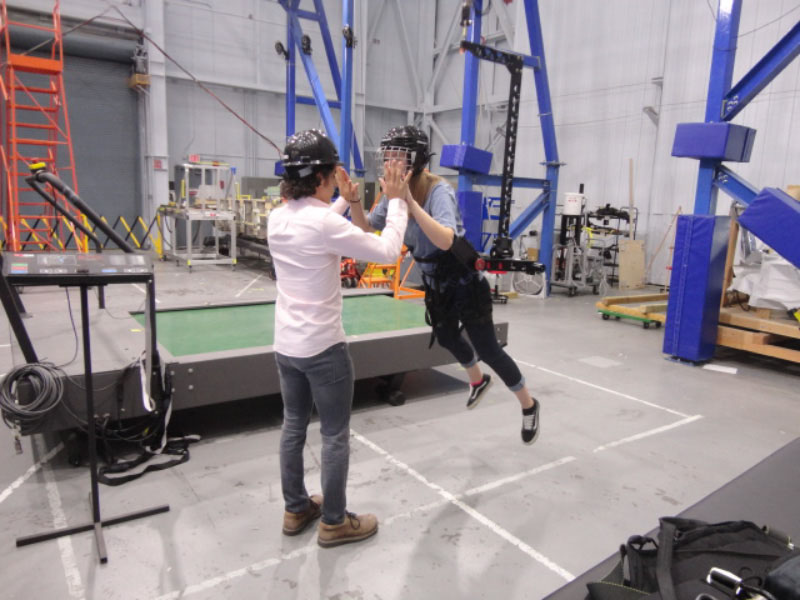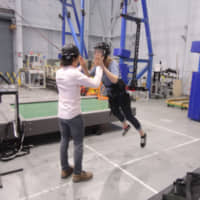Inside the biomedical engineering labs at NASA, scientists are charged with developing advanced life-support machines to help astronauts breathe for longer in space.
Others have developed custom equipment — space gyms, in a sense — enabling astronauts to complete full-body workouts on the International Space Station; exercise helps counteract the perpetual problem of microgravity causing accelerated bone and muscle loss among astronauts.
Meanwhile, inside Doshisha University’s labs in Kyoto, a unique project aims to incorporate research surrounding ways to utilize the adverse conditions encountered by astronauts in space toward helping mitigate health issues on Earth.
The Doshisha Space-DREAM (Doshisha Research Project for Active Life in Space Engineering and Medical Biology) Project was launched in April last year, calling upon individuals from around the world. Its goal involves bringing together a broad spectrum of academic fields connected to human health to use space bioengineering as a base for interdisciplinary research.
Notably, it will look into a prominent societal issue faced by Japan and many other advanced nations — how to prolong a healthy life in aging societies.
Japan is presently one of the world’s oldest countries demographically, with the number of people over 65 totaling around 34 million (26.6 percent of its population of roughly 127 million) in 2015, according to the National Institute of Population and Social Security Research. The institute estimates the percentage will increase to 35.3 percent by 2040 and 38.1 percent by 2060, assuming the median estimate of fertility ratio will be 1.44 in the long term.
Meanwhile, according to the World Health Organization, Japan’s average life expectancy was 81.1 years for men and 87.1 years for women last year.
Doshisha’s Space-DREAM project is designed on the premise that healthy life can be extended by exploring ways to improve, or even prevent, various conditions that commonly affect the elderly, such as Locomotive Syndrome, a condition of reduced mobility due to impairment of the musculoskeletal system.
In super-aging societies such as Japan’s, it’s widely believed that many people are likely to experience Locomotive Syndrome, which in addition to mobility disorders such as osteoporosis is caused by diabetes-inducing Metabolic Syndrome and high blood pressure.
Exercise has been shown to be an effective intervention for improving motor function, but has obvious limitations with elderly people, especially those who experience degenerative diseases of the musculoskeletal system.
Doshisha’s Space DREAM project focuses its research on body functions in outer space, which would seem counterintuitive considering the types of symptoms affecting the elderly are well known to be compounded by microgravity.
However, according to project leader Nobutaka Tsujiuchi, who is a professor at Doshisha’s Department of Mechanical and Systems Engineering, such observations can prove useful when applying space biomedical technology, which takes into account how body functions acclimate to outer space and seeks out ways to mitigate or prevent that acclimation.
“This led to the establishment of a plan that could tackle the issue of extending healthy life expectancies for the average citizen on Earth,” said Tsujiuchi, whose extensive body of research includes exploring movement under microgravity, simulated using an anti-gravity treadmill.
Doshisha researchers who are involved in the Space-DREAM project will also collaborate with scientists around the globe, including those at NASA’s Johnson Space Center, the European Space Agency and the Italian Space Agency.
The program has already attracted attention from several quarters, including the Japanese government.
Last year, Doshisha University was selected by the Ministry of Education, Culture, Sports, Science and Technology (MEXT) for its “private universities research branding project.” This program is designed to encourage university presidents to instigate research that exemplifies the unique characteristics of each institution.
With its global and progressive outlook, not to mention its unswerving respect for freedom of research — especially that which stands to benefit wider society — university President Takashi Matsuoka believes the Space-DREAM project was well-matched to Doshisha’s founding tenets and future goals.
Interestingly, the Space-DREAM project was already underway at the time of selection, but was hailed by MEXT as an example of research with “huge potential” for success, not to mention “further enhancement” of the university’s branding strategy.
Acknowledging that the chances of such success are improved through maximizing the breadth and scope of those involved, Space-DREAM has been incorporated in the research activities of other leading educational research bases run by Doshisha, including the Institute for Technology, Enterprise and Competitiveness and the Life Risk Research Center, as well as around 40 other research centers, “acting as our research base for solving the most current issues,” said Tsujiuchi.
“Universities are increasingly expected to deepen their insights regarding the effects of technological advancements on society and how people and society come to be,” he said.
As research platforms and how they’re implemented in everyday society evolve, Tsujiuchi believes it is also necessary for universities to continue maintaining a balance between competition and cooperation. “Our comprehensive university will use the scientific and technological research results of this project to continue striving to solve both humanitarian and scientific problems as they develop in the fields of social welfare and other social sciences,” he said.
In addition to contributing toward advancements in space biomedical engineering, Tsujiuchi explained the project also promotes other medical endeavors seeking practical application. Projects include new kinesiotherapy options for astronauts and those who have trouble walking, as well as developments in rehabilitation and pharmaceuticals.




